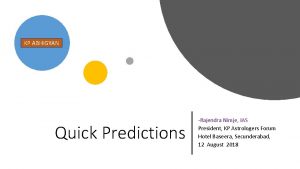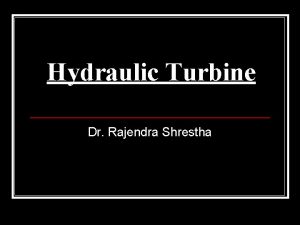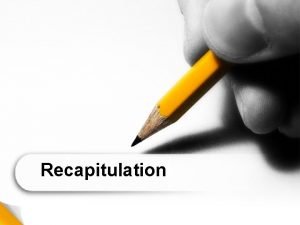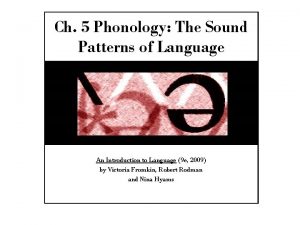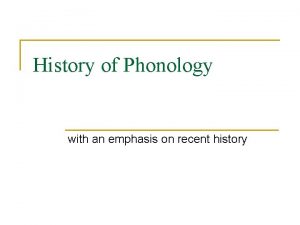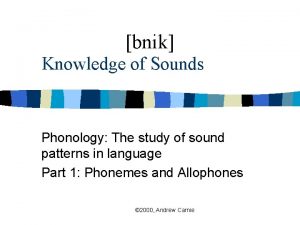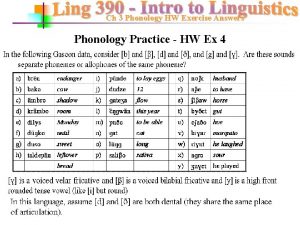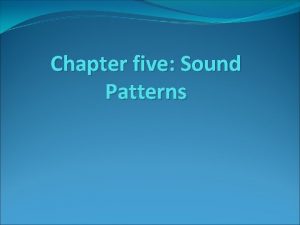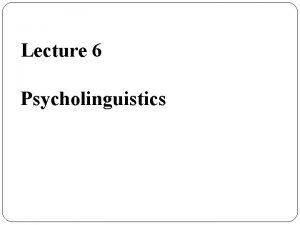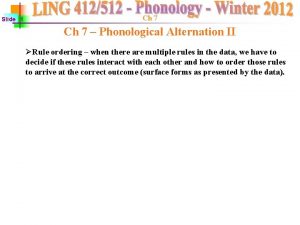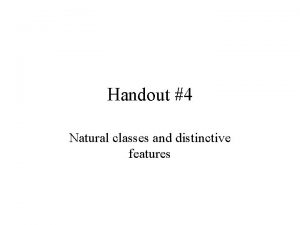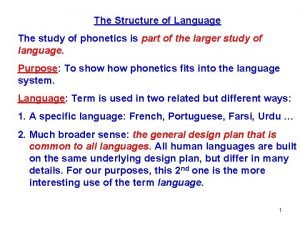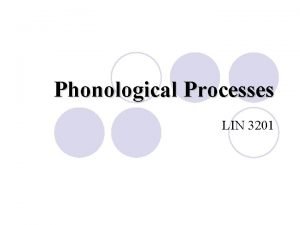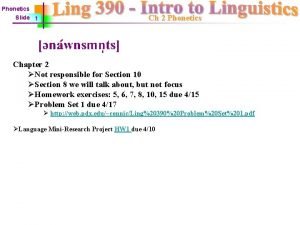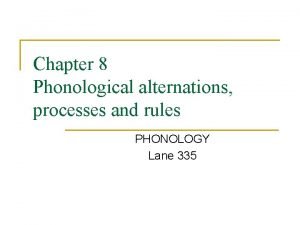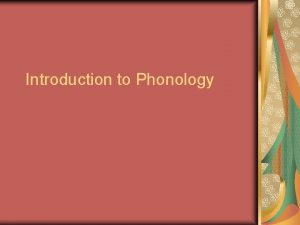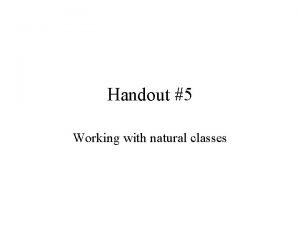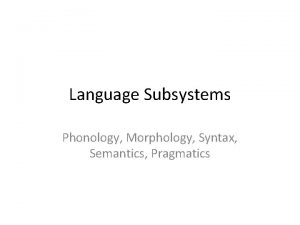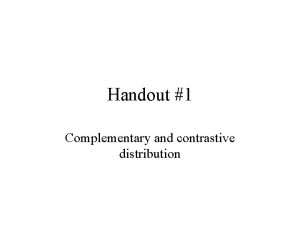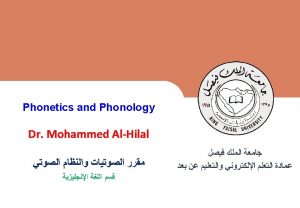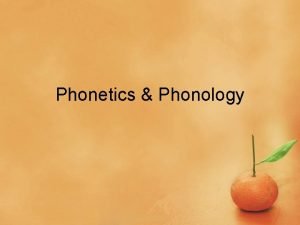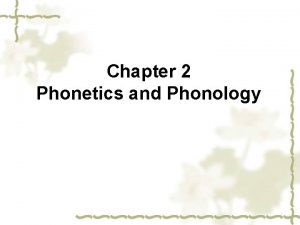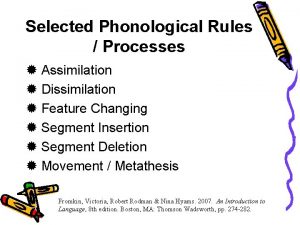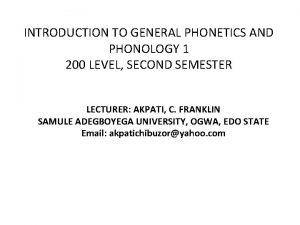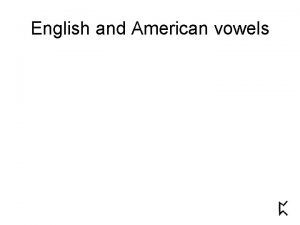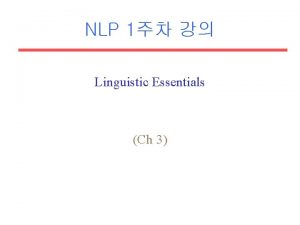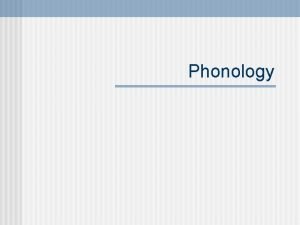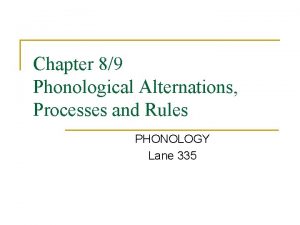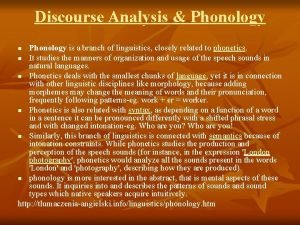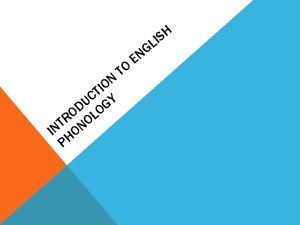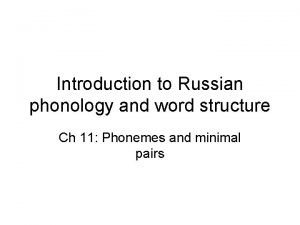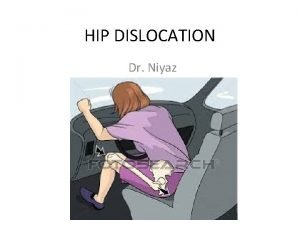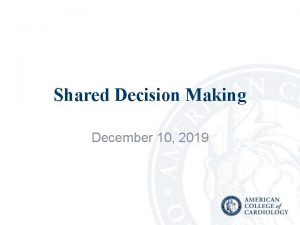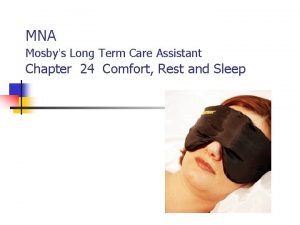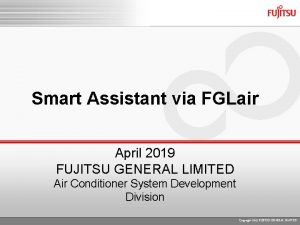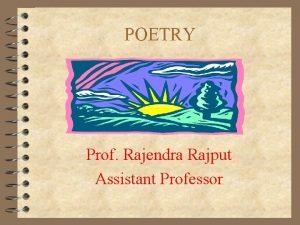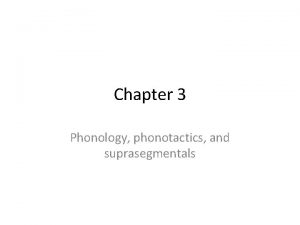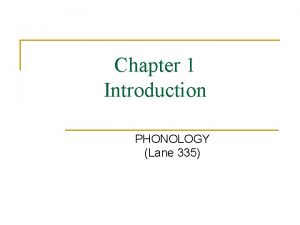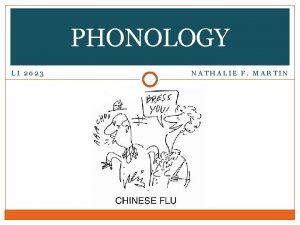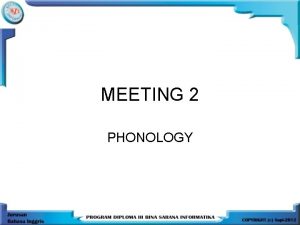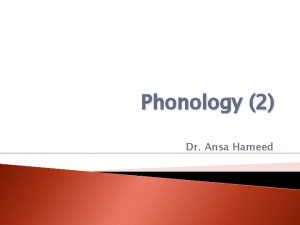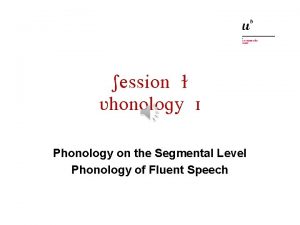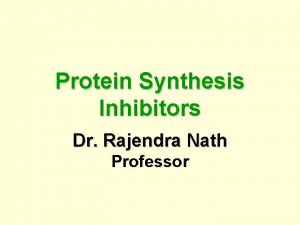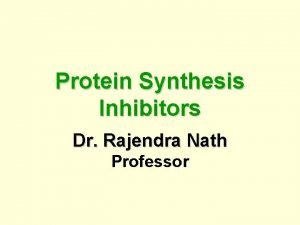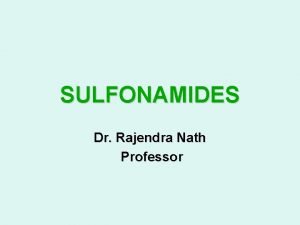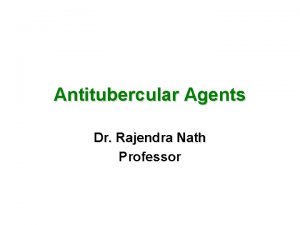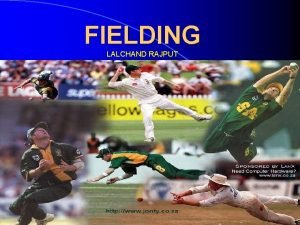PHONOLOGY Prof Rajendra Rajput Assistant Professor PHONOLOGY Systematic

























![Manner of Articulation (2/5) 4 Nasal sounds [n], [m], and [ng] are made by Manner of Articulation (2/5) 4 Nasal sounds [n], [m], and [ng] are made by](https://slidetodoc.com/presentation_image/0095b0c1c99c9d37eb7ae2ce9ecfa50e/image-26.jpg)




























- Slides: 54

PHONOLOGY Prof. Rajendra Rajput Assistant Professor

PHONOLOGY : Ø Systematic use of sounds in Language. Ø Spoken Language. Ø Science of speech sounds of Language.

PHENEME : A smallest distinctive sound unit Speech sounds of Language.

Phonetics : 4 The study of speech sounds.

What is the difference? Share your ideas with a partner. Phonetics The study of speech sounds. Phonology The study of the Language

Organs of Speech :

Speech Mechanism : 4 Concept is formulated 4 Air stream coming out in Speaker’s brain. 4 Linguistic codification is transmitted by Speech Organs. of the lungs. 4 Speech organs play their own role in the production of Speech sounds.

Minimal Pairs 4 Two words with different meanings that are the same except for one sound that occurs in the same place in each word 4 Example: cap, cab or cat, mat

Vowels :

(Pure Vowels/ Monophthongs) 4 1. /i: / 4 2. /I/ 4 3. /e / 4 4. /æ/ 4 5. /a: / 4 6. /ɒ/ initially east it end art ox medially sheet hit send sand heart fox finally key duty car

(Pure Vowels/Monophthongs) 7. /ɔ: / 8. /U/ 9. /u: / initially all put ooze 10. / / up 11. /з: / 12. /ə/ earn ago medially ball choose finally saw chew cup learn police stir maker

Places of articulation

Vowels :

Vowels :

Vowels

Diphthongs : 4 13. /eɪ/ 4 14. /əʊ/ 4 15. /aɪ/ 4 16. /aʊ/ 4 17. /ɔɪ/ 4 18. /ɪə/ 4 19. /eə/ 4 20. /uə/ eight oak ice out oil ears airs cured straight joke mice shout boil beard paired tour stay slow my how boy peer hare

Consonant sounds 4 1. /p/ 4 2. /b/ 4 3. /t/ 4 4. /d/ 4 5. /k/ 4 6. /g/ initially pin bin tell day keep get medially spin tubs stick heads skill jugs finally keep club light laid stick bag

Consonant sounds initially medially finally 4 7. /ʧ/ chin reached teach 4 8. / ʤ / joke hinged large 4 9. /m/ met net rings lot smoke snake sing fling team tin 4 10. /n/ 4 11. /ŋ/ 4 12. /l/ full

Consonant sounds 4 13 /f/ 4 14. /v/ initially fan van medially finally soft if leaves thief 4 15. /ɵ/ thin months bath 4 16. /ð/ then clothes bathe

Consonant sounds 4 21. /h/ 4 22. /r/ 4 23. /w/ 4 24. /j/ initially hot rot watt yatch medially finally behave try sweat tune

4 Repeated VOWEL sounds in a line or lines of poetry. (Often creates near rhyme. ) Lake Fate Base Fade (All share the long “a” sound. )

Place of Articulation : 4 Labial: Consonants whose main restriction is formed by the two lips coming together have a bilabial place of articulation. In English these include [p] as in pet [b] as in bear, and [m] as in met. 4 Dental: Sounds that are made by placing the tongue against the teeth are dentals. The main dentals in English are the [th] of thing or the [dh] of though, which are made by placing the tongue behind the teeth with the tip slightly between the teeth.

Place of Articulation (2/3) 4 Alveolar: The alveolar ridge is the portion of the roof of the mouth just behind ALVEOLAR the upper teeth. . 4 Palatal: The roof of the mouth (the palate) rises sharply from the back of the alveolar ridge. The palato-alveolar sounds [sh] (shrimp), [ch] (china), [zh] (Asian), and [jh] (jar) are made with the blade of the tongue against this rising back of the alveolar ridge. The palatal sound [y] of yak is made by placing the front of the tongue up close to the palate.

Place of Articulation (3/3) 4 Velar: The velum or soft palate is a movable muscular flap at the very back of the roof of the mouth. The sounds [k] (cuckoo), [g] (goose), and [N] (kingfisher) are made by pressing the back of the tongue up against the velum. 4 Glottal: The glottal stop is made by closing the glottis (by bringing the vocal folds together).

Manner of Articulation : 4 All consonants are produced by restriction of airflow 4 Manner of Articulation: How the restriction is produced: – complete or partial stoppage 4 A stop is a consonant in which airflow is completely blocked for a short time. 4 This blockage is followed by an explosive sound as the air is released. The period of blockage is called the closure and the explosion is called the release. 4 English has voiced stops like [b], [d], and [g] as well as unvoiced stops like [p], [t], and [k]. 4 Stops are also called plosives
![Manner of Articulation 25 4 Nasal sounds n m and ng are made by Manner of Articulation (2/5) 4 Nasal sounds [n], [m], and [ng] are made by](https://slidetodoc.com/presentation_image/0095b0c1c99c9d37eb7ae2ce9ecfa50e/image-26.jpg)
Manner of Articulation (2/5) 4 Nasal sounds [n], [m], and [ng] are made by lowering the velum and allowing air to pass into the nasal cavity. 4 Fricatives, airflow is constricted but not cut off completely. The airflow that results from the constriction produces a characteristic “hissing” sound. – The English labiodental fricatives [f] and [v] are produced by pressing the lower lip against the upper teeth, allowing a restricted airflow between the upper teeth. The dental fricatives [th] and [dh] allow air to flow around the tongue between the teeth. – The alveolar fricatives [s] and [z] are produced with the tongue against the alveolar ridge, forcing air over the edge of the teeth. – In the palato-alveolar fricatives [sh] and [zh] the tongue is at the back of the alveolar ridge forcing air through a groove formed in the tongue.

Manner of Articulation (3/5) 4 Fricatives, airflow is constricted but not cut off completely. The turbulent airflow that results from the constriction produces a characteristic “hissing” sound. – The higher-pitched fricatives (in English [s], [z], [sh] and [zh]) are called sibilants – Stops that are followed immediately by fricatives are called affricates; these include English [ch] (chicken) and [jh] (giraffe).

Manner of Articulation (4/5) 4 In approximants, the two articulators are close together but not close enough to cause turbulent airflow. In English [y] (yellow), the tongue moves close to the roof of the mouth but not close enough to cause the turbulence that would characterize a fricative. 4 In English [w] (wood), the back of the tongue comes close to the velum. 4 American [r] can be formed in at least two ways; with just the tip of the tongue extended and close to the palate or with the whole tongue bunched up near the palate.

Some places of articulation: bilabial consonants lips p pie b buy m mute w wood

Labiodental consonants upper teeth lower lip f fine v vine

Dental consonants upper teeth tip of tongue θ thin ð this

Alveolar consonants alveolar ridge tip/blade of tongue t tie d n night l die light s Sue z zoo

Post-alveolar / palato-alveolar consonants ʃ shoe, pressure ʧ cheap ʤ jeep Ʒ pleasure r rack

Palatal consonants j yes

Velar consonants velum back of tongue k curl g girl ŋ rang

Some manners of articulation: plosives or stops Bilabial: p b Alveolar: t d Velar: k g

Fricatives (think friction) Labiodental: f v Alveolar: s z Palato-alveolar or post-alveolar: ʃ Ʒ

Oral Nasal (Velum is lowered, allowing air to enter the nasal cavity)

Nasals Bilabial: m Alveolar: n Velar: ŋ

Summary of Places of Articulation Bilabial (lips) p b m w • Labiodental (lips and teeth) f fine v vine • Dental (tongue and teeth) θ thin ð then • Alveolar (tongue and alveolar ridge) tdsznl • Palato-alveolar (tongue and front part of hard palate) ʃ shoe ʒ measure ʧ cheap ʤ jeep r • Palatal (tongue and hard palate) j yes • Velar (tongue and velum) k g ŋ running • Glottal (glottis) h •

Summary of manners of articulation 4 Plosive / Stop pbtdkg 4 Fricative f v θ ð s z ʃ ʒ h 4 Affricate (stop + fricative) ʧ ʤ 4 Nasal m n ŋ 4 (lateral) l

Syllable : 4 One sound prominent than others. 4 It is usually vowel. 4 Exam- cat 4 Sometimes a consonant can occupy the central position in a syllable. 4 Exam- cotton 4 They are called syllabic consonants. 4 They can form a syllable without a vowel.

Syllables : 4 One syllable – monosyllabic 4 Two syllables – disyllabic 4 Three syllables – trisyllablic.

Word Accent : 4 Important feature of English. 4 A masculine force on some syllables. 4 It gives words music. 4 A word is made of syllables , while a sentence is made of words. 4 All the words in a sentence are not equally important as all the syllable are not equally important in a word.

Word Accent : 4 Those that are more prominent than others are said to receive the accent. 4 It is due to Stress – greater masculine force.

Types of Accent : 4 Primary Accent : The syllable on which there is a pitch change. 4 vertical bar above and in front of the syllable. 4 Exam : able captain master 4 Secondary Accent : Any other prominent syllable. 4 Vertical bar below the syllable.

Stress Shift : 4 Weather the word is used as a noun , an adjective or a verb. 4 The accent is on the first syllable when the word is a noun / an adjective. 4 Accent is on the second syllable when it is a verb. 4 Exam : object

Intonation : 4 Continual variations 4 The voice is pitched. 4 Speaking voice resembles singing voice. 4 Intonation can be used to convey information that is not expressed by the words. 4 Stress and intonation are linked to give the effect of prominence.

4 The speakers emotions degree of intensity effect intonation. 4 Used by native speakers of language. 4 Foreign speakers need a lot of practice.

Tone : 1) Static : a) High level tone : vertical bar above. b) Low level tone : vertical bar below 2) Kinetic : a) a falling tone b) A rising tone c) Falling rising tone

Falling Tone : 4 In an ordinary statement made without emotions. Exam : the water is warm. 4 Questions beginning with Wh – Exam : What is your name ? 4 In commands Exam : Come here.

Rising Tone : 4 In complete utterances. Exam : It’s seven o’ clock. 4 In questions which demand an answer. Exam : Are they coming? 4 Questions in warm friendly manner. Exam : How is your mother ? 4 In polite requests. Exam : Please sit down.

Falling – Rising Tone : 4 Special implication. 4 The listener should understand more than a literal interpretation of the words. 4 Apology, unpleasant news, happiness, doubt. 4 Exam : The houses are nice.

Thank you Best Of Luck
 Rajendra nimje
Rajendra nimje Dr rajendra shrestha
Dr rajendra shrestha Cuhk assistant professor salary
Cuhk assistant professor salary Promotion from assistant to associate professor
Promotion from assistant to associate professor Differences between phonetics and phonology
Differences between phonetics and phonology The sound patterns of language
The sound patterns of language Autosegmental phonology
Autosegmental phonology What is segmental phonology
What is segmental phonology Linking in phonology
Linking in phonology Complementary distribution examples
Complementary distribution examples Phonology exercises with answers
Phonology exercises with answers Free variation and complementary distribution
Free variation and complementary distribution Difference between phonetics and phonology
Difference between phonetics and phonology Dipping intonation
Dipping intonation Non segmental phonology
Non segmental phonology Quenya phonology
Quenya phonology Language
Language Alternation in phonology
Alternation in phonology Manner features
Manner features Recursion in language
Recursion in language Phonology process
Phonology process Phonetics ch
Phonetics ch Phonological alternation examples
Phonological alternation examples Phonetics speech sounds
Phonetics speech sounds What is phonology in linguistics
What is phonology in linguistics Natural classes in phonology
Natural classes in phonology Elearning
Elearning Natural classes phonology
Natural classes phonology What are minimal pairs in linguistics
What are minimal pairs in linguistics Phonology syntax semantics pragmatics
Phonology syntax semantics pragmatics Complementary or contrastive distribution
Complementary or contrastive distribution Phonetic units that appear in square brackets
Phonetic units that appear in square brackets The difference between phonetics and phonology
The difference between phonetics and phonology Phonetics and phonology
Phonetics and phonology Phonetics vs phonology
Phonetics vs phonology Dissimilation definition
Dissimilation definition Introduction to general phonetics and phonology
Introduction to general phonetics and phonology American english phonology
American english phonology Example phonology
Example phonology Contrastive distribution
Contrastive distribution Alpha notation phonology
Alpha notation phonology Discourse analysis and phonology
Discourse analysis and phonology Phonetics and phonology
Phonetics and phonology Segmental phonology
Segmental phonology Introducing phonology answer key
Introducing phonology answer key Russian allophones
Russian allophones Assistant
Assistant Manifesto for school head girl
Manifesto for school head girl Medicare assistant
Medicare assistant Ibm support assistant workbench
Ibm support assistant workbench Veternary
Veternary The assistant chapter 24
The assistant chapter 24 Fglair google home
Fglair google home When did you last go
When did you last go Qcm validation formation assistant maternel
Qcm validation formation assistant maternel
